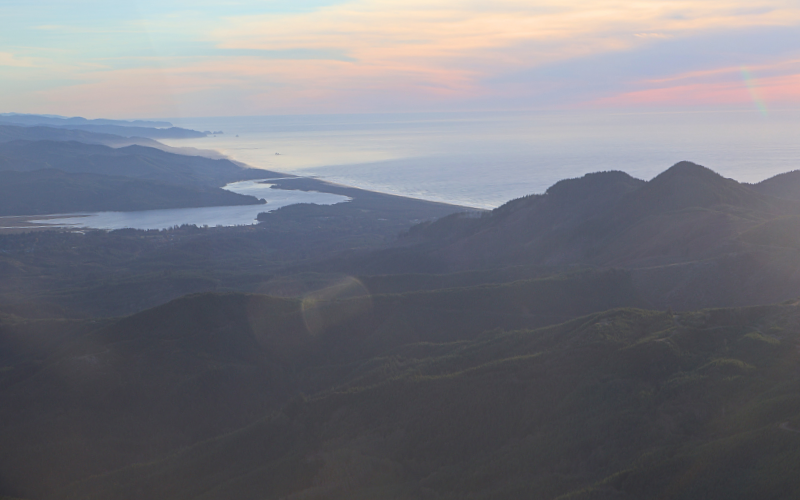
In November, I had the unique experience of heading up into the sky to get a bird’s-eye view of the northern Oregon Coast, from Nehalem Bay up to the Columbia River. I’ve never seen the Oregon Coast from this vantage point, so it was a first for me, thanks to longtime NCLC volunteer and board member Randall Henderson and his self-made plane.
Here are a few photos I managed to take along the journey, many that contain bits of North Coast Land Conservancy’s conserved habitat reserves and the surrounding coastal communities. I hope you enjoy!

Looking south over the mountains to the Nehalem Bay and adjacent coastline. In the Nehalem area, you’ll find our Fishers Point Habitat Reserve. We’ve also facilitated a few projects here, including the Nehalem Bend Easement and Botts Marsh Habitat Reserve.
Here, you’ll see parts of Cape Falcon Marine Reserve, Oswald West State Park (including Short Sand Beach), the Arch Cape Community Forest, and the Rainforest Reserve—a remarkable corridor of public and conserved waters and lands. It’s an incredible view, and so impactful in terms of seeing how these areas are all connected. There are no real boundaries. And it’s a worthwhile reminder that everything we do on land affects the ocean, and vice versa. One of our priorities at NCLC is long-landscape conservation that focuses on habitat and ecosystem connectivity.
My only hesitation with including this photo is the blatant visibility of several clearcuts. But while not beautiful, they are a reality, and I feel honesty and authenticity are paramount. I’m happy I can say, however, that with the acquisition of the 3,500-acre Rainforest Reserve in 2021, we’ll be able to care for some of that land and steward its restoration and rewilding.


Onion Peak, a majestic part of the Rainforest Reserve, and perhaps one of the most well-recognized and iconic elements. It is home to a diverse collection of plant and wildlife species, some of which are endemic to this area.
A view of the Cape Falcon Marine Reserve. Although managed by the Oregon Department of Fish & Wildlife as one of five marine reserve sites in Oregon, we are fortunate to be able to provide education, stewardship, and advocacy around this special marine environment. We established our Marine Program of NCLC in 2022, when we adopted the program from the Friends of Cape Falcon Marine Reserve group.


Many people are likely familiar with these landmarks, including the magnificent Haystack Rock and Tillamook Head. One of our facilitated projects in the area includes the Ecola Creek Forest Reserve, which was led by the city of Cannon Beach. Additionally, our Boneyard Ridge Habitat Reserve is at the center of a contiguous 3,500-acre conservation corridor on Tillamook Head.
Finally, looking north to the mighty Columbia River. I think what struck me most about viewing this part of the coast from above was observing the intricate patchwork of water and earth. Those two elements truly work in tandem to shape the specific ecosystems that surround and hold us on the Oregon Coast, including the coastal wetlands, prairies, sloughs, and rivers. The confluence of the Pacific Ocean and the Columbia River influences the ecology and geology of the area in innumerable ways. Aren’t we fortunate to also be part of their story?

Comments